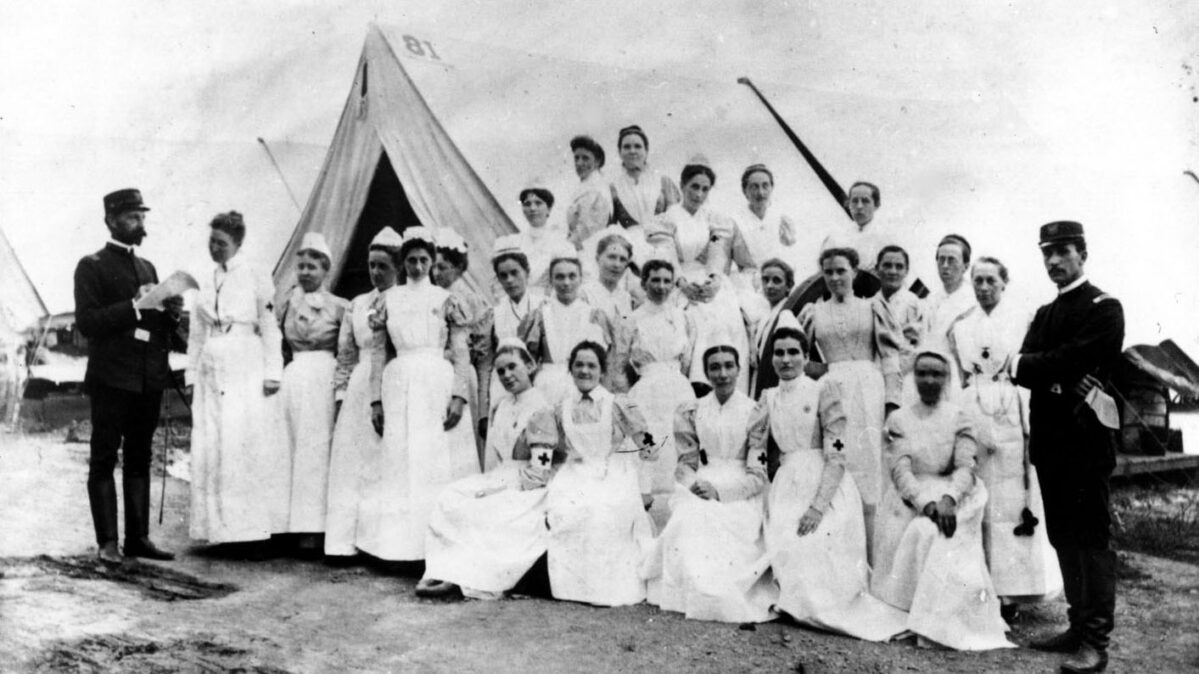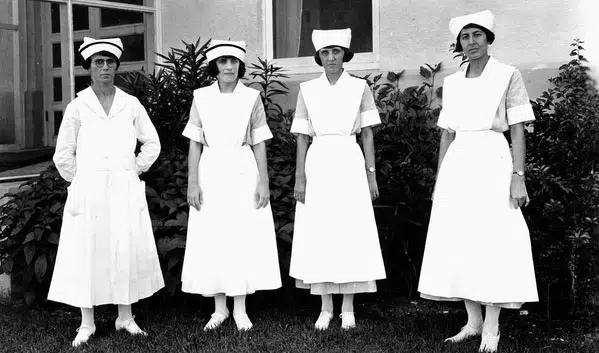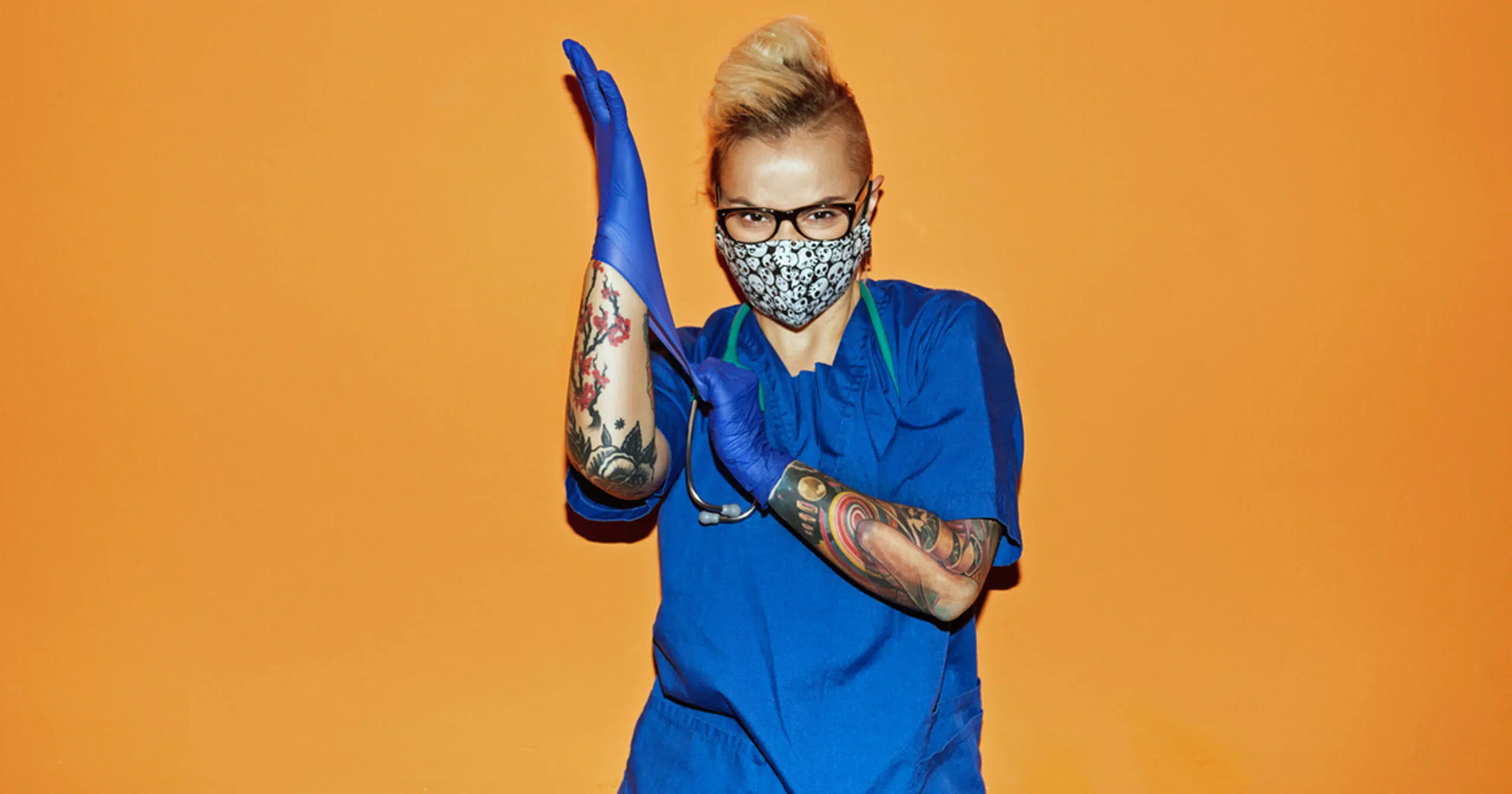Your alarm didn’t go off this morning, leaving you no time to shower. Your hair’s a mess, you spilled a little coffee on your nursing uniform and you notice a stain on your scrub top left by your child as you rush out the door for work. But amidst the chaos, you wonder, does any of this truly matter in the world of nursing? After all, your expertise remains unchanged, regardless of coffee stains or less-than-stellar appearance.
While this example may be a bit dramatic, the point is — your appearance as a nurse does matter.
According to a study published in The Journal of Applied Nursing Research, a nurse’s appearance significantly influences the perceptions of patients and their families regarding a nurse’s professionalism. Join us as we explore the rich history of nursing uniforms and the transformative journey that has contributed to nurses becoming one of the most trusted professions in the nation.
The History of Nursing Uniforms & Scrubs

Traditional nursing uniforms have a history dating back to the late 19th century, inspired in part by the pioneering work of Florence Nightingale. The uniforms of that era typically consisted of long dresses, aprons and caps, symbolizing professionalism, purity and obedience in nursing practice. However, as healthcare evolved, so did nurse attire.
The 1940s witnessed a transition to all-white uniforms, emphasizing cleanliness, while the dynamic decades of the 1950s and 60s brought about dramatic changes in nursing fashion. This era saw the introduction of male scrubs and modifications to the female uniform, including dresses with shorter sleeves, open-neck designs and even pant options. As the 1970s and 80s unfolded, nursing caps became optional in most hospitals and nurse uniform trends leaned more casual, paving the way for the scrubs seen today.
With their enhanced mobility and ease of cleaning, scrubs emerged as a preferred uniform choice, aligning with Nightingale’s emphasis on infection control and efficient patient care.
Impact of Dress Code on Patient Perception
The effect of dress code on how patients perceive healthcare professionals goes beyond just appearance. On a subconscious level, seeing a nurse in professional attire profoundly influences patient comfort and confidence. The clothing worn by nurses and doctors can evoke feelings of reassurance, respect and authority, helping foster a positive patient-provider relationship.
However, cultural and generational differences are pivotal in shaping these perceptions. What may be considered appropriate attire in one cultural context might be perceived differently in another. Similarly, generational preferences regarding apparel vary, with older patients often valuing traditional dress codes while younger generations may prioritize comfort and practicality. Understanding and respecting these nuances is crucial for healthcare providers to effectively communicate trust and competence, ultimately enhancing the patient experience and outcomes.
A review by the American Nurses Association (ANA), consisting of literature, patient surveys and expert advice, explored the impact of nursing dress codes on patient perception. The ANA found that by implementing evidence-based dress code policies, healthcare organizations can effectively convey a sense of professionalism, competence and dedication to patient care. It determined that nursing dress codes enhance the staff’s professional image and foster trust and confidence in patients. The article underscores the importance of aligning dress code policies with evidence-based practices to ensure consistency, professionalism and patient satisfaction in healthcare settings.
Trust and Professionalism

Trust is one of the essential pillars within the healthcare industry and is a crucial feeling patients want to have for their nurses. Building trust starts with the first impression a nurse gives when entering a patient’s room. A nurse’s demeanor should balance professionalism and friendliness, laying the groundwork for a strong bond.
According to the ANA study above, precise identification is the foremost recommendation for gaining trust. Patients and their families seek reassurance through easily identifiable healthcare professionals. Hospitals enhance clarity and confidence in patient-provider interactions by adopting various means for easy identification, such as name bands with designations, color-coordinated uniforms or designated name tags indicating roles like “RN” or “LPN.”
Another study published in The Online Journal of Issues in Nursing confirms the importance of nursing dress code policies in shaping the quality of patient experience. It emphasizes that attire significantly influences patients’ perceptions of professionalism, competence and trustworthiness. The study suggests that clear and consistent nursing dress code policies enhance nursing staff’s professional image and contribute to improved patient satisfaction and outcomes. By establishing guidelines for appropriate nurse dress codes, healthcare organizations can effectively communicate a sense of respect, authority and dedication to patient care.
Practical Considerations of Nursing Attire
When it comes to nursing attire, it’s important to balance professionalism, function and comfort while maintaining hygiene and safety standards. Nurses require a uniform that allows them to perform their duties efficiently while projecting a professional image to patients and colleagues.
Many medical scrubs available today aim to combine a professional appearance with comfort and practicality. Among our preferred online sites to buy scrubs from is Scrubs and Beyond, offering a diverse range of brands suited for all body shapes and budgets and a loyalty program for its customers.
RELATED: Seeking the Perfect Nursing Scrubs: A Comprehensive Guide to Comfort and Fit
For new nurses entering practice, important factors to consider when exploring various nurse uniform options include:
- Comfort: Nursing attire should prioritize comfort to support you during long shifts and various tasks.
- Functionality: Nurse apparel should facilitate ease of movement and practicality to enable you to perform your duties efficiently.
- Hygiene: Clothing should be easy to clean and maintain to uphold strict hygiene standards in healthcare environments.
- Professionalism: Nursing uniforms should convey a professional image, instilling confidence and trust in patients and colleagues.
- Safety: Considerations such as appropriate footwear and jewelry minimize injury risks and promote a safe working environment.
Dress Code: Beyond Clothing

Nursing dress code policies extend beyond clothing to encompass various aspects of personal grooming and appearance, each carrying its own set of norms and potential impacts on perception and professionalism.
Tattoos and body piercings, for example, may be subject to regulations depending on the healthcare institution’s policy. Visible tattoos or excessive piercings potentially influence perceptions of professionalism or patient comfort. However, policies can vary on this issue.
Using perfume, cologne or heavy makeup can influence patient interactions by potentially triggering allergic reactions or discomfort. It’s worth noting that many healthcare and hospital environments are scent-free zones.
Many facilities have policies regarding fingernails and jewelry that aim to maintain hygiene standards and prevent potential injury to patients or healthcare workers. Even sock choice and picking the best nursing shoes can impact comfort, safety and professionalism, with healthcare-specific footwear often required for support and infection control.
Nursing Dress Code Policies across Healthcare Settings
Dress code policies in healthcare settings vary nationwide, tailored to meet each environment’s unique needs and culture. Standardized uniforms are mandatory in hospitals like the University of Colorado Health (UCHealth), where professionalism, infection control and patient safety are paramount.
In clinics, virtual nursing and private practices, dress code policies may be more relaxed, allowing healthcare professionals to wear personal clothing that reflects their individual style while still maintaining a professional appearance.
Personal clothing grants autonomy and may enhance staff morale but can also result in inconsistencies in appearance and potentially compromise infection control measures.
Striking the right balance between standardized uniforms and personal clothing is essential for each healthcare setting to uphold professionalism, ensure patient confidence and facilitate optimal care delivery.
What Are the Benefits of Standardized Nursing Uniforms?
- Cohesive team identity
- Easy identification of healthcare providers
- Adherence to strict hygiene standards
- More professional and reliable appearance
- Increased trust with patients and their families
Future Trends and Innovations in Nursing Attire

Scrubs have come a long way from the simple and natural 100% cotton fiber variety. Many nurses seeking the perfect scrubs today opt for a cotton/polyester blend to get the best of both fabrics in breathability and durability. Other great options are high-performance fabrics that are quick-drying, moisture-wicking and stain-resistant, although these scrubs tend to be more expensive.
Research and development laboratories have been working on smart fabrics, or e-textiles, with rapidly evolving technology for over a decade. Although there are no known instances yet of e-textiles being integrated into nurse attire, the intersection of healthcare and innovation hints at a possible future where these fabrics will transform the way nurses dress. This will eliminate the need for separate wearable health devices. E-textiles are made by combining conductive fibers with biomedical sensors, microcontrollers, fiber optics and wearable antennas. These fabrics will seamlessly transmit health data directly to your apps via Bluetooth.
As smart textiles become more attainable, nurses could soon benefit from uniforms offering temperature control, advanced moisture-wicking and vital signs monitoring. While the idea of Bluetooth-enabled attire raises health concerns, it presents an intriguing concept for the future.
There is a cultural shift happening in healthcare with regard to nursing dress codes. The focus is now on striking a balance between professionalism, individual expression and comfort. Healthcare institutions are looking to create inclusive and supportive environments for their staff, and dress code policies are adapting to reflect this. Personalization is becoming more acceptable while still maintaining standards of professionalism and infection control. This shift is part of a broader trend toward human-centered design in healthcare. It aims to prioritize the needs of patients and healthcare providers by offering innovative solutions for nurse attire.
Now that you have your wardrobe taken care of, are you ready to explore exciting opportunities in the healthcare industry? Browse Vivian’s jobs pages to discover various nursing positions tailored to your preferences and expertise. Sign up for Vivian or download the app to take your career to new heights today.









